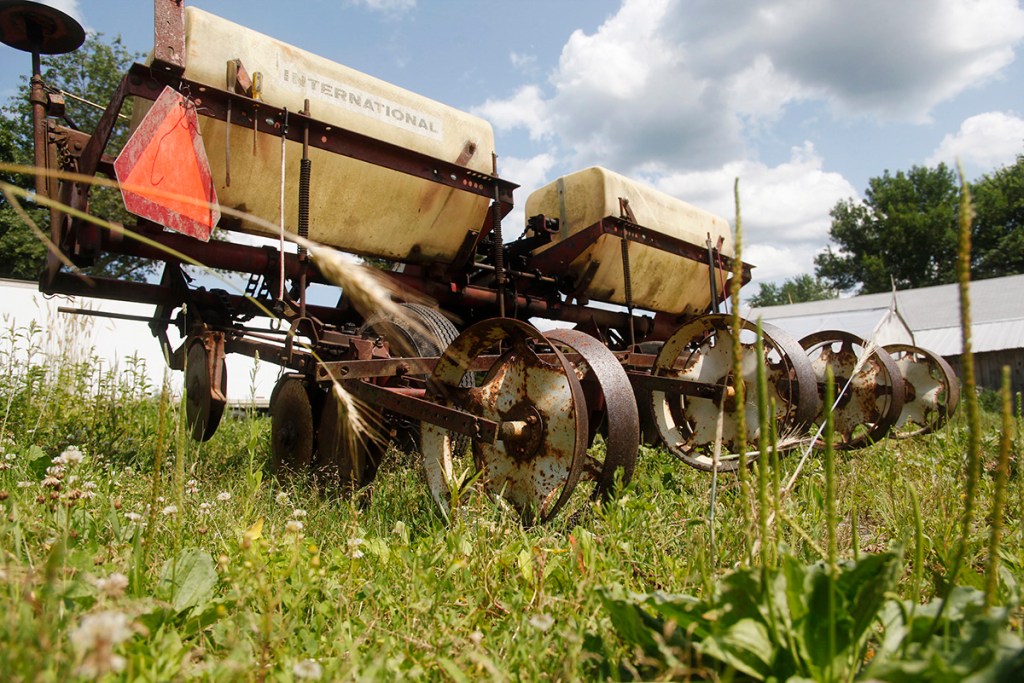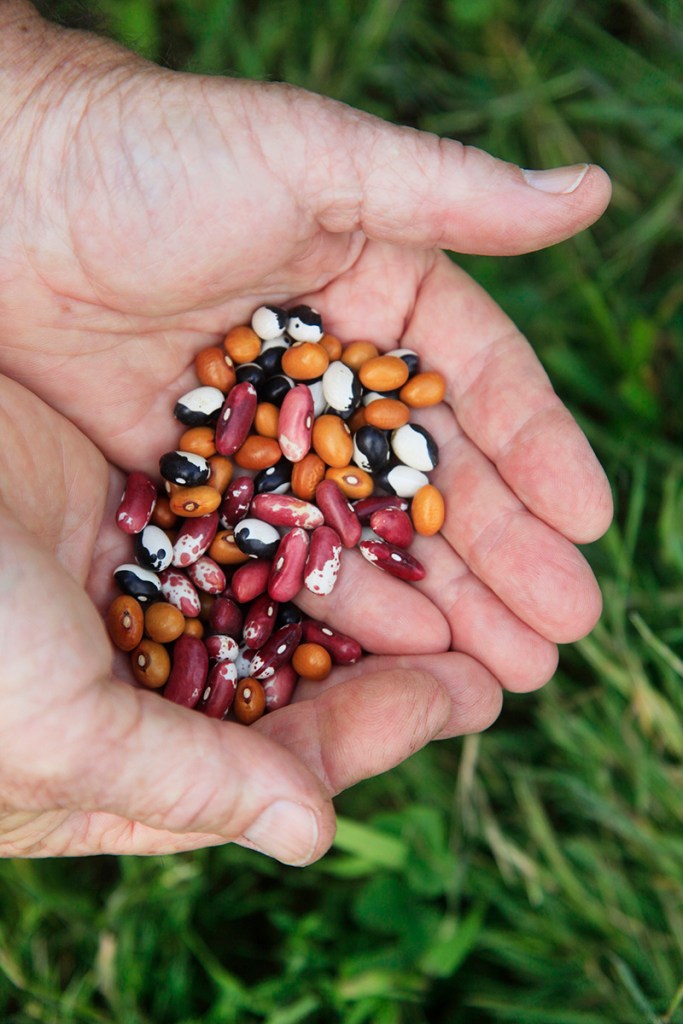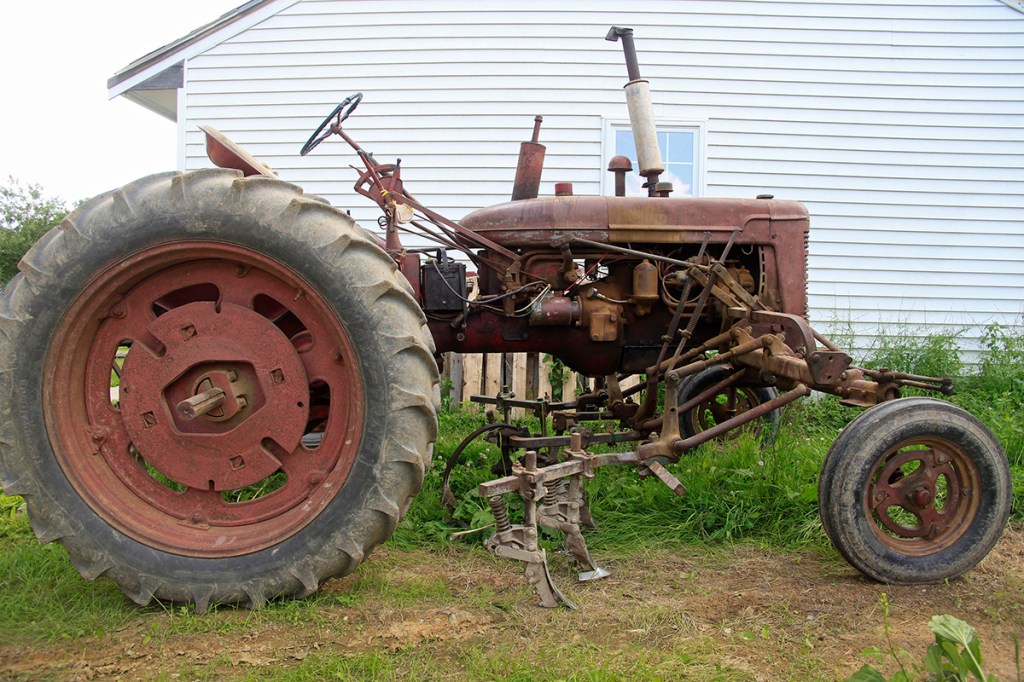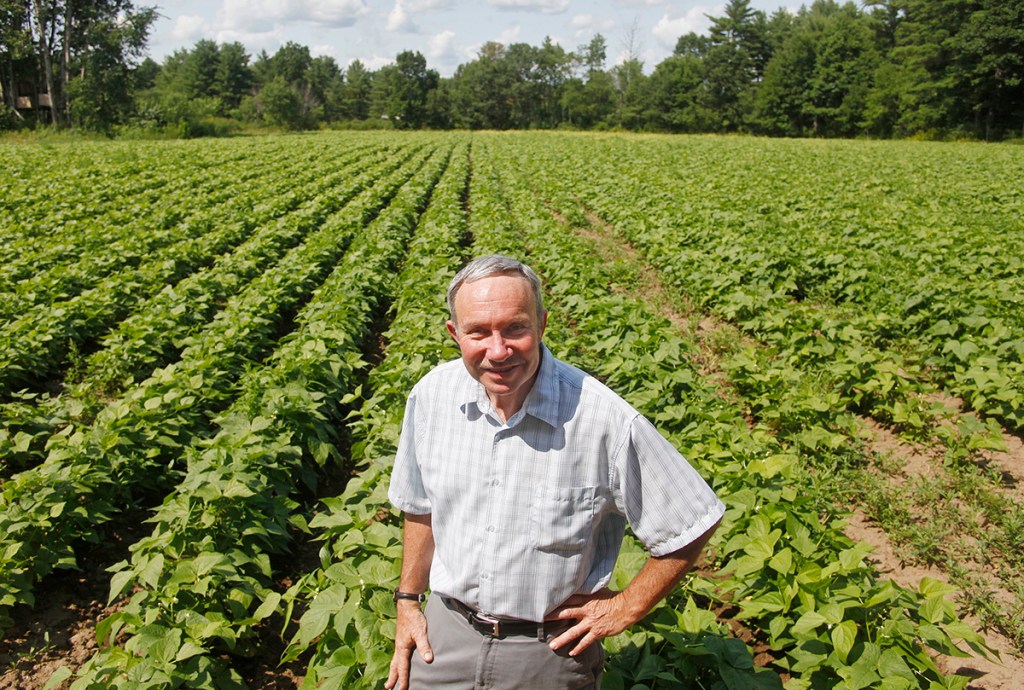SOUTH BERWICK — Charley Baer looks over a field of small green plants stretching to the horizon. “Those are sulfur beans,” he says, pointing in one direction. “Over there are bumblebee beans. And there are Jacob’s Cattle.” Right now the plants growing in this field look like any backyard bean. But these are destined to be dried beans, a staple in New England cuisine for centuries and darlings of today’s nutritionists.
Baer, a compact man whose face is tanned from the sun and whose hands are weathered from work, grows 20 varieties of mostly heirloom beans on conservation land in southern Maine, the most variety of any farmer in New England, he says. “If I grew 20 acres of Bumblebees (beige with a brown mark that looks like a bee), I’d never (be able to) sell them.” But with so many varieties, he has a niche selling Baer’s Best Beans to gourmet stores in Massachusetts, at summer and winter farmers markets there, in New Hampshire and Maine, farm stands and stores in North and South Berwick, and to Johnny’s Selected Seeds in Winslow, Maine.
“We’re the Rancho Gordo of the East,” he jokes, referring to the Napa Valley heirloom beans that are widely sold in gourmet shops.
SUPPERS NOTWITHSTANDING
New England is famous for its bean suppers and the region has a legacy of bean growers. Historically, dried beans were a good staple for long Maine winters – nutrition-dense, low in calories and high in protein, minerals, and vitamins. Farmers in the past grew diverse crops, including beans, often for their own tables.
Today, Maine has more bean growers than other New England states, according to the USDA Agricultural Statistics Service New England office. But that doesn’t mean beans will ever rival blueberries or potatoes as a key crop. The number of dried bean growers in Maine dropped from 35 in 2002 to 18 in 2012; the acreage in dried bean production is about the same, adds Gary Keough, state statistician of the USDA office in Concord, New Hampshire. Instead, commercial dried bean production these days is mostly in western states, where the climate is better suited.
The 10 acres of fields at Baer’s Lover’s Brook Farm and another 10 acres of land rented nearby are planted with cannellini beans, Scarlet Runners, Boston Roman, and flageolet, Tolsano, Black Cocoa, Peregion, Money Beans, Yellow Eye, Calypso and more.
Other bean farmers in Maine, such as Green Thumb Farm in Fryeburg, Osborne Family Farm near Orono, and Freedom Bean Co. in Albion, stick to four to six varieties, mostly heirloom Jacob’s Cattle, Yellow Eye and soldier beans.
With their long growing time – most varieties are planted in June and will not be ready to harvest until September or even October – growing beans is a waiting game for farmers.
As for consumers, why buy dry beans locally when every supermarket sells them – and for less? Baer’s beans retail for about $5 a pound at farmers markets, compared to about $1.29 per pound for supermarket beans (and $5.95 per pound for Rancho Gordo). But try this: Simmer a pot of dry beans that have been on a shelf for years. Do the same with locally grown beans from the previous season. The reason to buy local will be clear. Even when the beans are dried, Baer explains, freshness matters. Commercially grown beans can be years old and some have been dried too long. They’ll seemingly store forever but will take hours to soften in cooking (or they may never soften at all). Freshly dried beans, by contrast, will cook in less than an hour; the flavors and colors will be vibrant, the beans more nutritious.
CULTIVATING KNOWLEDGE
Baer squeezes the hard, physical labor of planting, weeding, harvesting, sorting and drying beans in with his career as a chemist testing water purity and analyzing water systems all over the country – and the world – for Thermo Fisher Scientific. In the spring and fall, that can mean an extra 40 hours on top of his day job. Baer, who had gardened as a child, got interested in farming in the late ’70s when friends went “back to the land” in central Maine. He would drive up to help them, and happened to meet their neighbor, an older farmer who was passionate about beans. The farmer taught Baer not only how to grow beans but how to modify and maintain machinery specific to bean farming. The knowledge, Baer says, was as much about weather, deer control, and how to cobble together machinery for bean cultivation and harvesting, as it was plant lore.
Over the years, Baer has experimented with more than 100 varieties – such as heirloom soldier beans and Yellow Eye – that were developed in Maine and grow well here, as well as ones that failed to thrive, such as chickpeas. This year, he hopes to harvest 30,000 pounds of beans from his land. That is, if the predators stay away and the weather cooperates.
Every year, his hope is for a dry spell in the fall so that the beans, by then in dry pods that look almost dead, are ready to harvest. “I’d take a wet spring every year if I knew I’d have a dry fall.” His biggest concern, though, is not the live plants but keeping his old tractors, combines and other equipment running. All are old – one tractor was manufactured just a few years after World War II ended – and the cultivators for weeding between rows and other implements must be hand-welded. Unlike with other types of farming, he explains, there are no manufacturers building new machines specifically for beans in New England because there are so few bean farmers. (Western farmers use huge machines that wouldn’t work in Maine’s small, often wet fields.) He and his four part-time employees spend a lot of time repairing, adapting, and tuning up tractors, trucks, and other machinery.
But wet autumns aside, this land is good for bean growing, Baer says. When glaciers covered the land, the fields “used to be under the sea.” The glaciers melted, leaving fertile land with good drainage, perfect for beans. Rye is planted in the fall after harvest; it adds nutrients when it is plowed under in the spring.
Baer grows primarily without herbicides, and about half of his acreage is under strict organic standards; he is working toward putting full certification into place. To control deer, which love the tender little plants, he and his workers put up electrified fencing. Woodchucks are another problem, eased by foxes, coyotes and other predators. “If it was up to me, I’d bring back wolves,” he says with a chuckle.
As he shows the equipment in one of his barns, ancient-looking contraptions such as a gravity separator used to sort the beans by weight, he explains some of the procedures that occur after fall harvest. The beans are cleaned, sorted by weight to remove the shriveled beans, then cleaned again and hand-picked, all very important for high-quality beans. They’re dried in burlap bags with fans for several weeks, and then packed into clear plastic bags with a label showing a little brown bear. By late fall, the beans that were planted in June will start appearing in markets.
In this era of reverence for locally grown, unusual variety and heirlooms, the demand for Baer’s beans is strong. He’d like another 10 acres and more equipment, so he could expand operations. For now, though, he and his workers are weeding, watching over the plants, and over the weather, too. As he says: “You can’t count the crop until it’s in the barn.”
Send questions/comments to the editors.










Comments are no longer available on this story